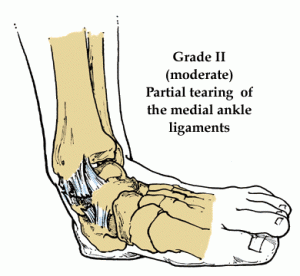What is the difference between a ‘strain’ and a ‘sprain’?
 In last month’s newsletter, we announced a new section of our newsletter where you, the patient, could ask Drew a health related question that you have been curious about. We had several responses and have chosen the following question in our first installment of ‘Ask Drew’.
In last month’s newsletter, we announced a new section of our newsletter where you, the patient, could ask Drew a health related question that you have been curious about. We had several responses and have chosen the following question in our first installment of ‘Ask Drew’.
Q: What is the difference between a ‘strain’ and a ‘sprain’?
A: This is a very commonly confusing distinction. At one point or another in most of our lives we have suffered from both, most of the time we didn’t care what it was called because it hurt the same.
A strain is an overload of muscles or tendons that causes tearing of the fibers. They are also commonly refereed to as a ‘pulled muscle’. Depending upon the amount of fibers that are torn, a muscles strain is classified by first-degree, second-degree and third-degree (the worst) strains.
 A sprain refers to an overload on the ligaments that stabilize a joint. They are also labeled according to degrees of first, second and third depending upon the number of torn fibers involved.
A sprain refers to an overload on the ligaments that stabilize a joint. They are also labeled according to degrees of first, second and third depending upon the number of torn fibers involved.
It is not uncommon to suffer both in an injury. Both sprains and strains can be painful, but oddly enough sometimes first and second-degree occurrences of these conditions can be more painful than third degree injuries. This is because the fibers are completely torn and there isn’t a tensile load being placed upon the fibers.
If you have a health related question, please ‘Ask Drew’
(Comments and suggestions from Drew do not constitute a diagnosis. ‘Ask Drew’ is intended for informational purposes only.)
[divider]
Ask Drew!
Each month we will be selecting a question from one of our patients to explore in the following month’s newsletter. We know you have many questions about wellness related topics such as understanding injuries, managing stress, etc…and we want to offer you a platform to ask Drew a question directly that would also benefit other patients.
We look forward to receiving your questions!
Ready to #feelbetter?
You're just a click away from a wicked good massage!
-

60 Minute Massage Gift Card
$170.00 Add to cart -

90 Minute Massage Gift Card
$255.00 Add to cart -

Mini Aer Small Room Air Purifier
$149.00 Add to cart -
Sale!

Thera-Pearl Sports Pack/Hot Cold
Original price was: $14.99.$12.99Current price is: $12.99. Add to cart -

3 Somadome Sessions Gift Card
$135.00 Add to cart -

20 Minute Somadome Gift Card
$45.00 Add to cart -
Sale!

TheraBand® Stretch Strap
Original price was: $19.99.$14.99Current price is: $14.99. Add to cart -

TheraBand CLX Connective Loop
$14.99 Select options
Muscle Strains
A strain, sometimes referred to as a pulled muscle, is a muscle injury produced by excessive tensile stress that causes fibers to tear within the tissue. A muscle strain does not usually result from excess stretch alone, but from a combination of tension and contraction. Muscle strains can develop when excess tension is placed on…
Read MoreShin Splints or Compartment Syndrome?
One of the most common overuse injuries affecting the lower extremity is the condition known as shin splints. While the term shin splints routinely is used, especially among the athletic population, it does not represent a specific clinical pathology. Instead, it describes chronic shin pain resulting from overuse. It occurs in two regions of the…
Read MoreAn Alternative Approach to Stretching
Clinicians, athletes and rehabilitation specialists advocate stretching as a means for injury prevention and treatment. The primary purpose of any stretching technique is to enhance pliability and flexibility in the soft tissues. It is also routinely incorporated with massage in the treatment of pain and injury conditions. There are many different stretching techniques, which all…
Read MoreGanglion Cysts
The highly refined palpation skills of massage practitioners are such that we often identify tissue abnormalities before the client is aware of them. An indication that we should refer a patient for further evaluation is when we identify something we aren’t sure of but know shouldn’t normally be there. One such example may occur with…
Read MoreWhat Is the “End Feel”?
Some of the most valuable assessment information is derived from relatively simple procedures such as passive range-of-motion tests. While many massage practitioners have been exposed to the fundamental concepts of active and passive range-of-motion testing, most have not learned how to use this information effectively in a clinical environment. In this article, we will focus…
Read MoreHow Accurate Is That Test?
Physical assessment is considered one of the most accurate ways to assess function of the locomotor tissues of the body. While we can often gain valuable information about structural problems through high-tech diagnostic procedures like X-ray or MRI, these procedures tell us very little about the function of the tissues involved in creating and limiting…
Read MoreWhen Is It Tendinitis?
Tendinitis is one of the most common diagnoses for soft tissue pain resulting from repetitive motion. As repetitive motion disorders have dramatically increased, so has the incidence of tendinitis. However, recent investigations into the cellular nature of tendon pathologies have brought forth interesting discoveries that may alter the way tendinitis is treated. In this month’s…
Read More- « Previous
- 1
- …
- 18
- 19
- 20

